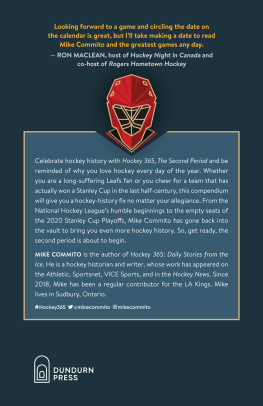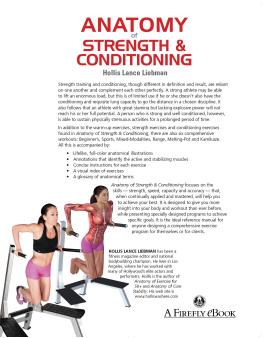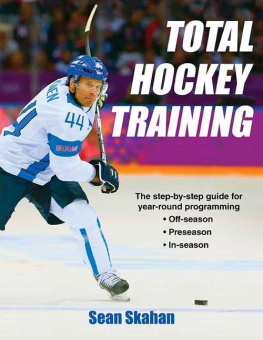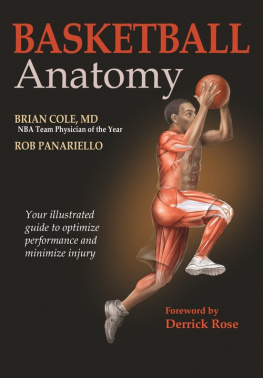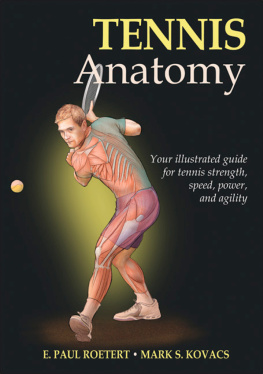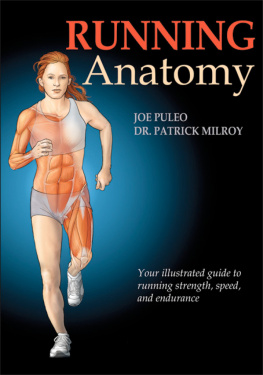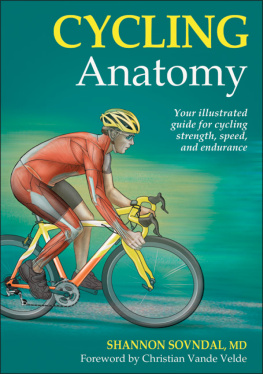Hockey
ANATOMY
Michael Terry, M.D.
Paul Goodman
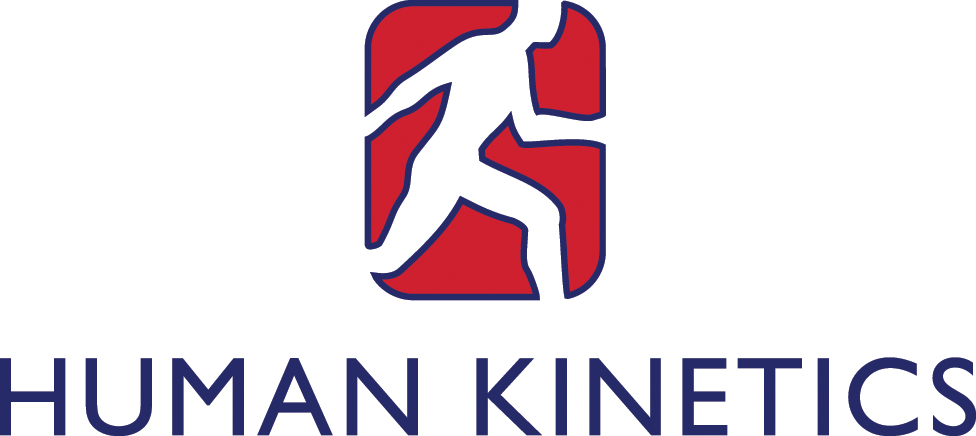
Library of Congress Cataloging-in-Publication Data
Names: Terry, Michael, 1971- | Goodman, Paul, 1974
Title: Hockey anatomy / Michael Terry, Paul Goodman.
Description: Champaign, IL : Human Kinetics, [2019]
Identifiers: LCCN 2018012594 (print) | LCCN 2017044916 (ebook) | ISBN 9781492566465 (ebook) | ISBN 9781492535881 (print)
Subjects: LCSH: Hockey--Training. | Hockey--Physiological aspects.
Classification: LCC GV848.3 (print) | LCC GV848.3 .T47 2019 (ebook) | DDC 796.356--dc23
LC record available at https://lccn.loc.gov/2018012594
ISBN: 978-1-4925-3588-1 (print)
Copyright 2019 by Michael Terry and Paul Goodman
All rights reserved. Except for use in a review, the reproduction or utilization of this work in any form or by any electronic, mechanical, or other means, now known or hereafter invented, including xerography, photocopying, and recording, and in any information storage and retrieval system, is forbidden without the written permission of the publisher.
This publication is written and published to provide accurate and authoritative information relevant to the subject matter presented. It is published and sold with the understanding that the author and publisher are not engaged in rendering legal, medical, or other professional services by reason of their authorship or publication of this work. If medical or other expert assistance is required, the services of a competent professional person should be sought.
The web addresses cited in this text were current as of June 2018 unless otherwise noted.
Acquisitions Editor: Diana Vincer; Senior Developmental Editor: Cynthia McEntire; Managing Editor: Ann C. Gindes; Copyeditor: Annette Pierce; Permissions Manager: Martha Gullo; Senior Graphic Designers: Nancy Rasmus and Joe Buck; Cover Designer: Keri Evans; Cover Design Associate: Susan Rothermel Allen; Photo Asset Manager: Laura Fitch; Visual Production Assistant: Joyce Brumfield; Photo Production Coordinator: Amy M. Rose; Photo Production Manager: Jason Allen; Senior Art Manager: Kelly Hendren; Illustrations: Human Kinetics; Illustrator: Heidi Richter; Printer: Versa Press
Human Kinetics books are available at special discounts for bulk purchase. Special editions or book excerpts can also be created to specification. For details, contact the Special Sales Manager at Human Kinetics.
Printed in the United States of America
10 9 8 7 6 5 4 3 2 1
The paper in this book is certified under a sustainable forestry program.
Human Kinetics
P.O. Box 5076
Champaign, IL 61825-5076
Website: www.HumanKinetics.com
In the United States, email info@hkusa.com or call 800-747-4457.
In Canada, email info@hkcanada.com.
In the United Kingdom/Europe, email hk@hkeurope.com.
For information about Human Kinetics coverage in other areas of the world,
please visit our website: www.HumanKinetics.com
E6874
I would like to dedicate this book to my children, William, Allison, and Thomas, and to my wife, Lynne. Thank you so much for everything.
- Michael Terry
This book is whole-heartedly dedicated to my wife, Susan. Her presence, ethic and beautiful disposition perpetually inspire and motivate me every second of every day.
- Paul Goodman
CONTENTS

FOREWORD
Lets face ithockey players are unlike any other athletes in the world. Im not taking anything away from other types of athletes, but I do think it takes a certain level of skill to fly around an area enclosed by solid, immovable walls, pushing into ice on thin metal blades while wearing extra pounds of equipment and using a stick to handle a tiny puckall while five opposing players literally try to put you through the glass.
Truth is, hockey players are unique because of the way we move. If you are a young player reading this, then you know that from an early age we hockey players are taught to move in unconventional ways to be able to propel ourselves on skates in every direction possible. Unlike running, skating requires speed and power in your quads, glutes, and calves as you push out to the side instead of to the back. Powerful skaters are almost always overdeveloped in these areas, which can help with performance but in the long term can lead to many other issues.
Point is, training your body to be fast, explosive, and powerful without giving up your mobility, athleticism, and longevity has never been more important. Im sure when you think of hockey, you think of speed and power. Training those skills is the fun part, and it can be easy to neglect your mobility and flexibility. But if you want to be your best for as long as possible, bringing all these different types of training together is crucial. This can become an intricate process. I mean, how can you focus on becoming great at all the on-ice skills if youre preoccupied with a never-ending checklist of off-ice training? Thankfully, thats where my good friends Paul Goodman and Dr. Mike Terry step in.
Dr. Mike Terry has been the orthopedic surgeon for the Chicago Blackhawks for 12 years. Not only has he seen a ton of orthopedic injuries, but he has also seen many recoveries. Comprehension of the human body is one thing, but he takes understanding of the hockey players anatomy to the next level. Seeing Dr. Terry usually means something has gone seriously wrong, and its time to take drastic measures to fix it.
On the other hand, your time with Paul Goodman has neither a beginning nor an end. Paul has been the strength coach for the Chicago Blackhawks for nearly the same stretch of time as Dr. Terry has been involved with the team. Work with Paul can range from initial injury prevention and in-season maintenance to off-season peak performance and injury rehabilitation. If you want to be a professional hockey player, you have to put your heart and soul into it. The same can be said for Pauls level of commitment to understanding what makes athletes great. Not only does he help you transform your body, but he also helps you improve your mental, emotional, and spiritual approach to the game.
A lot of people credit our three Stanley Cup championships in Chicago strictly to the players on the ice and, to a certain degree, it is understandably so. But what they fail to see is how many other skilled and gifted people behind the scenes have committed their lives to create that team success that you see on the ice or on television.
Paul and Dr. Terry are great examples of that. They are an amazing duonot only because of their separate and differing expertise but also because of how they are able to overlap and communicate that knowledge to each other. They are engaged with their players and help us through the process of understanding why we do what we do. They want us to ask questions, to learn, to grow.
Its important to learn through your own trial and error when you rise to the top, but sometimes you can take little shortcuts and learn through the failures and successes of other people to get to the next level. This book is a culmination of the years of hard work and hands-on experience of two people who have been working with top athletes for years. In other words, its a major shortcut, so use it to your advantage !
Hockey is a great sport because it constantly challenges you. There is always a new hurdle coming at you that pushes you to adapt, learn, and get better. I wish I had this book when I was much younger because its a tool I keep returning to which I will use for years to come. Whether you take a lot or a little from this book, never forget that the best players in hockey never stop learning and never stop improving their game.
Next page


